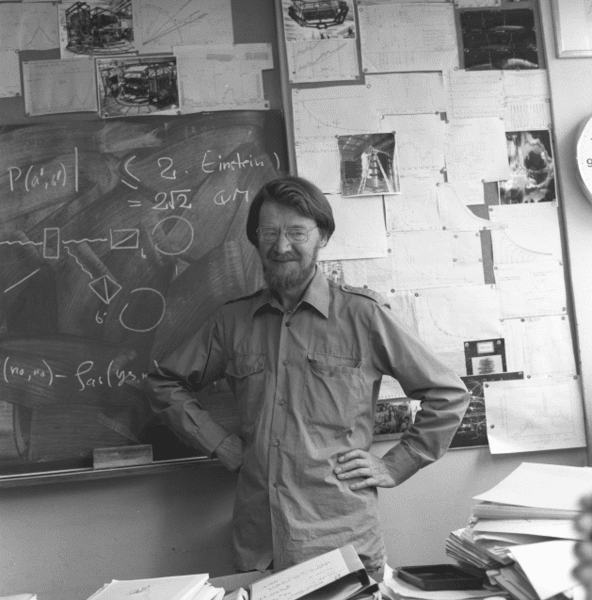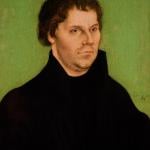
Wikimedia Commons public domain
Wikipedia defines “quantum entanglement” as “a physical phenomenon that occurs when pairs or groups of particles are generated or interact in ways such that the quantum state of each particle cannot be described independently of the others, even when the particles are separated by a large distance—instead, a quantum state must be described for the system as a whole.”
Here’s the second paragraph of that Wikipedia article:
“Measurements of physical properties such as position, momentum, spin, and polarization, performed on entangled particles, are found to be appropriately correlated. For example, if a pair of particles are generated in such a way that their total spin is known to be zero, and one particle is found to have clockwise spin on a certain axis, the spin of the other particle, measured on the same axis, will be found to be counterclockwise, as to be expected due to their entanglement. However, this behavior gives rise to paradoxical effects: any measurement of a property of a particle can be seen as acting on that particle (e.g., by collapsing a number of superposed states) and will change the original quantum property by some unknown amount; and in the case of entangled particles, such a measurement will be on the entangled system as a whole. It thus appears that one particle of an entangled pair ‘knows’ what measurement has been performed on the other, and with what outcome, even though there is no known means for such information to be communicated between the particles, which at the time of measurement may be separated by arbitrarily large distances.”
Albert Einstein never altogether liked quantum physics and, although he couldn’t get rid of them, he was troubled throughout his life by certain of its implications. In a 4 December 1926 letter to his fellow German-Jewish physicist Max Born (who would later win the 1954 Nobel Prize in Physics), he said that “eine innere Stimme” (“an inner voice”) told him that they weren’t right. That’s, for instance, what’s behind his famous comment, in that same letter to Max Born, that God (literally, “the Ancient One”) doesn’t play dice with the Universe (Jedenfalls bin ich überzeugt, daß der [Alte] nicht würfelt). He disliked quantum indeterminacy.
Einstein also noted quantum theory’s prediction of so-called “entangled particles,” and, in 1949, he compared that concept to telepathy. Why? Presumably because, for him, telepathy represented the ultimate in pseudoscientific nonsense. The point of his analogy, of course, was that he rejected as essentially “magical” or “occultic” the notion that separated particles could still be “entangled” when at a large distance from each other. It was a reductio ad absurdum argument. (See P. A. Schilpp, ed., Albert Einstein, Philosopher-Scientist, The Library of Living Philosophers [Evanston, IL, 1949], 683.)
But it seems that, great though he was, Einstein was wrong in this rejection of “quantum entanglement” — which, I suppose goes to illustrate that even the most illustrious scientists and thinkers can go wrong because of preconceptions and preferences.
In 1964, roughly nine years after Einstein’s death, the Irish physicist John Stewart Bell formulated a mathematical proof — in what has since been called “Bell’s theorem” — that quantum theory does genuinely entail “spooky action at a distance,” as he himself called it. (He probably borrowed that phrase, either directly or indirectly, from Einstein’s derisive reference to “spukhafte Fernwirkung” in a 3 March 1947 letter to Max Born, which could also be translated as “ghostly action at a distance.”) Sadly, Bell died unexpectedly in 1990 of a cerebral hemorrhage, only 62 years old and unaware that he had just been nominated for a Nobel Prize, which cannot be awarded posthumously.
But that was a theoretical, mathematical proof. Could “quantum entanglement” actually be shown to occur? In 1972, the American physicists Stuart Jay Freedman (1944-2012) and John F. Clauser (1942-) published the results of their successful experimental observation of quantum entanglement, thereby providing real-world support to Bell’s theorem. (See “Bell test experiments.”) In the early 1980s, the French physicist Alain Aspect (1947-) provided further experimental evidence for the proposition that “spooky action at a distance” actually exists and occurs.
So, how close is the analogy, really, between telepathy and quantum entanglement?
(Drawn, in part, from Dean Radin, Entangled Minds: Extrasensory Experiences in a Quantum Reality [New York: Paraview/Pocket Books, 2006], 72-76].)












